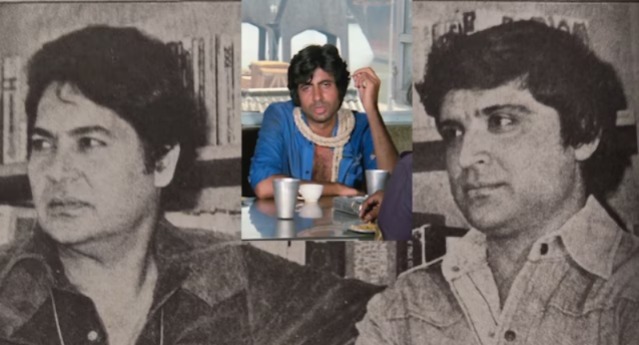In the annals of Indian cinema, the partnership of Salim Khan and Javed Akhtar, collectively known as Salim-Javed, stands as one of the most iconic duos in Bollywood history. Their contribution to Indian cinema is unparalleled, not just for the memorable films they crafted, but also for the way they redefined the role of screenwriters in an industry that had traditionally relegated them to the shadows. However, their rise to prominence wasn’t just about their creative genius; it was also about their groundbreaking business acumen. This article delves into the fascinating story of how Salim-Javed earned more than Amitabh Bachchan, the superstar they helped create, with a staggering fee of Rs 21 lakh—a sum that was unheard of for screenwriters at the time. The partnership between Salim Khan and Javed Akhtar began in the early 1970s, a time when Bollywood was undergoing significant transformations. Salim Khan, a former actor, had transitioned into writing, while Javed Akhtar, a poet and lyricist, was looking for opportunities to break into the film industry. Their paths crossed on the sets of Sarhadi Lootera (1966), a film where both were working in different capacities. Recognizing each other’s talent, they decided to collaborate, and this partnership would soon become legendary. Their first notable success as a duo came with Andaz (1971), a film that marked the beginning of their rise in Bollywood. However, it was with Zanjeer (1973) that Salim-Javed truly established themselves as the most sought-after writers in the industry. Zanjeer was a game-changer, not only for the duo but also for Amitabh Bachchan, who was catapulted to stardom with his portrayal of the “Angry Young Man”—a character archetype that would become synonymous with Bachchan and define a new era in Hindi cinema. Before Zanjeer, Amitabh Bachchan was struggling to make a mark in the industry. He had delivered a series of flops and was on the verge of being written off as a leading man. However, Salim-Javed saw something in him that others didn’t. They recognized that Bachchan’s brooding intensity, tall frame, and deep voice were perfect for the character they had envisioned—a disillusioned, angry cop who takes on a corrupt system. Zanjeer was a stark departure from the formulaic romantic films that dominated Bollywood at the time. It was gritty, intense, and socially relevant, tapping into the frustrations of the common man. The success of the film was unprecedented, and it not only revived Bachchan’s career but also established Salim-Javed as the most influential writers in the industry.
How Salim-Javed Earned More Than Amitabh Bachchan: The Iconic Story Behind Their Rs 21 Lakh Fee
The character of the “Angry Young Man” became a recurring theme in Salim-Javed’s work, and films like Deewaar (1975), Sholay (1975), and Trishul (1978) further cemented their reputation. Each of these films was a box office blockbuster, and Bachchan’s portrayal of morally complex, rebellious characters became iconic. However, while Bachchan became the face of these films, it was Salim-Javed’s writing that provided the foundation for his success. Traditionally, screenwriters in Bollywood were considered secondary to directors and actors. They were often underpaid and lacked the recognition they deserved. Salim-Javed changed this dynamic by demanding not just higher fees but also respect and creative control. They insisted on being credited prominently in the film’s opening titles, a practice that was almost unheard of at the time. Their success gave them leverage, and they used it to negotiate better terms for themselves. By the mid-1970s, they were commanding fees that were unprecedented for writers. But their most audacious move came when they negotiated a fee of Rs 21 lakh for writing the script of Shakti (1982)—a sum that was more than what Amitabh Bachchan, the leading actor, was being paid. The story behind the Rs 21 lakh fee is as much about business savvy as it is about creative excellence. By the time Shakti was in the works, Salim-Javed were at the peak of their careers. They had delivered a string of blockbusters and were considered the architects of Amitabh Bachchan’s superstardom. They knew their worth and weren’t afraid to demand it. When producers approached them for Shakti, a film that would bring together two of the biggest stars of the time—Dilip Kumar and Amitabh Bachchan—Salim-Javed recognized that they held the cards. The script was central to the film’s success, and they were the best in the business. So, they set their price at Rs 21 lakh, a figure that was astronomical by the standards of the day. This fee was not just a reflection of their market value; it was a statement. Salim-Javed were asserting that writers were as crucial to a film’s success as its stars and directors. Their demand sent shockwaves through the industry, but it was also a wake-up call. It forced producers to acknowledge the importance of good writing and set a new precedent for how writers were treated in Bollywood. Salim-Javed’s demands went beyond just financial compensation. They also insisted on creative control over their scripts, which was a rarity in an industry where writers were often expected to churn out scripts according to the director’s or producer’s vision. Salim-Javed, however, were different. They wrote scripts with a distinct voice and style, and they were not willing to compromise on their creative integrity. Their scripts were tightly woven narratives with well-defined characters, memorable dialogues, and strong moral conflicts. This was a departure from the more formulaic storytelling that was common in Bollywood at the time. By demanding creative control, Salim-Javed ensured that their vision was faithfully translated to the screen, which in turn contributed to the success of their films.
